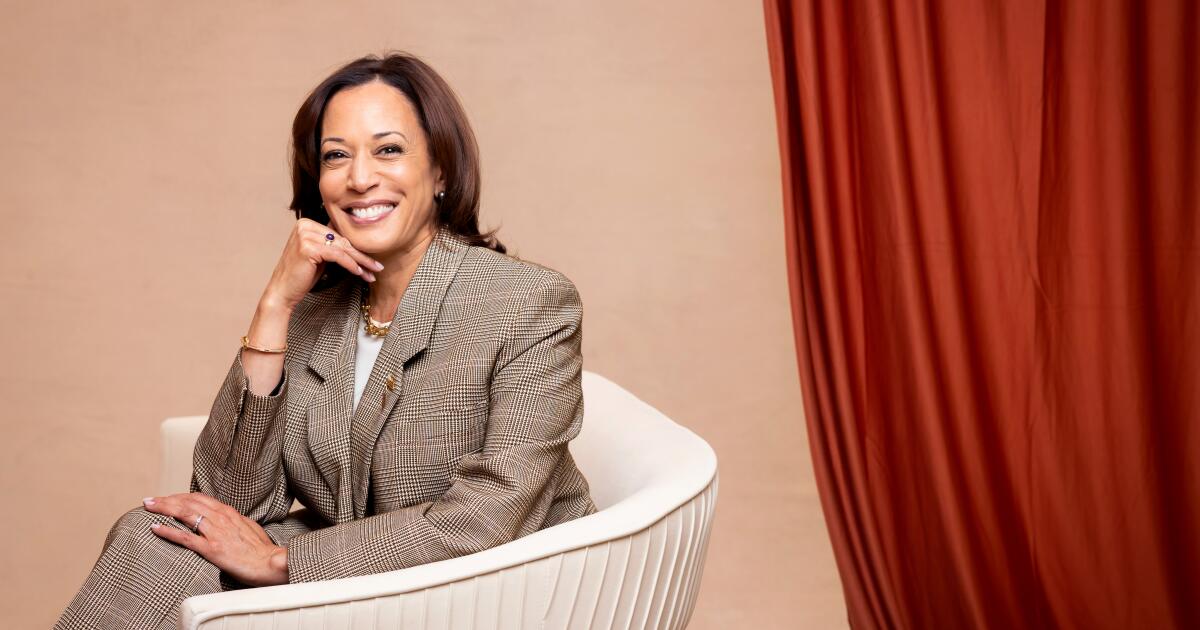
Kamala Harris is making history once again, this time in a way few could have imagined.
She has already blazed trails: as the first female district attorney of San Francisco. As the first female attorney general of California. As the second Black woman elected to the U.S. Senate. And, of course, as the nation’s first female, first Black, and first Asian-American vice president.
Now, at a pivotal moment in American history, Harris, a 59-year-old Democrat, is poised to become the Democratic presidential nominee after President Biden withdrew from the race on Sunday.
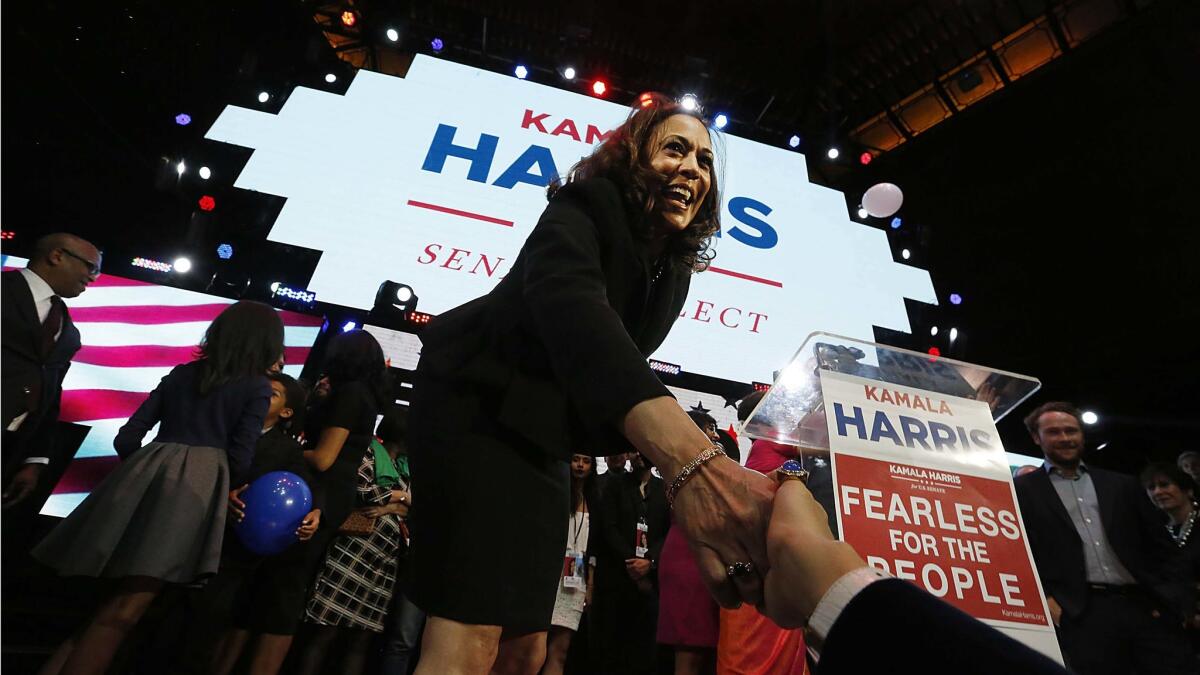
Kamala Harris greets supporters on election night after winning her 2016 U.S. Senate race.
(Barbara Davidson/Los Angeles Times)
Biden, 81, faced with concerns about his age and electability, withdrew from the race — a decision Harris called a “selfless and patriotic act” — and endorsed his runner-up.
If she receives the nomination at the Democratic National Convention in Chicago next month, Harris will become the first woman of color to lead a national ticket and, if she wins, the first female president.
“We have 107 days until Election Day,” Harris said in a statement Sunday. “Together we will fight. And together we will win.”
Nonprofit fundraising platform ActBlue said that as of 6 p.m. PT Sunday, $46.7 million had poured in from grassroots supporters in the hours since Harris’ campaign launched.
Harris, who publicly endorsed Biden as calls for his resignation after a disastrous June debate performance intensified criticism that he was too old and frail to serve four more years, steps into her new role at a time of great turmoil and tension within the Democratic Party.
She will undoubtedly face fierce attacks from Republicans, who have united behind their candidate, Donald Trump, the twice-impeached and convicted former president who narrowly survived an assassination attempt two days before the start of last week’s Republican National Convention.
“I will do everything in my power to unite the Democratic Party – and unite our nation – to defeat Donald Trump and his extreme Project 2025 agenda,” Harris wrote on the social media platform X, referring to the more than 900-page manifesto written by conservative thought leaders and Trump acolytes.
California Gov. Gavin Newsom, long considered a political foe of Harris’s, whose rise as a Bay Area Democratic star has paralleled his own, wrote Sunday that the vice president is “tough. Fearless. Tenacious.”
“With our democracy on the line and our future at stake, there is no one better positioned to continue Donald Trump’s dark vision and guide our country in a healthier direction than US Vice President @KamalaHarris,” he posted on X.
Harris, a former prosecutor, is a product of the same turbulent Bay Area politics that has produced some of the nation’s most prominent Democrats, including Newsom, former House Speaker Nancy Pelosi and former U.S. Sens. Dianne Feinstein and Barbara Boxer.
She has demonstrated tenacity throughout her political rise, from her successful 2003 campaign for San Francisco district attorney — in which she defeated a Democratic incumbent and her former boss — to her failed 2020 presidential campaign, during which she sharply criticized Biden on the debate stage for his record on school busing to desegregation.
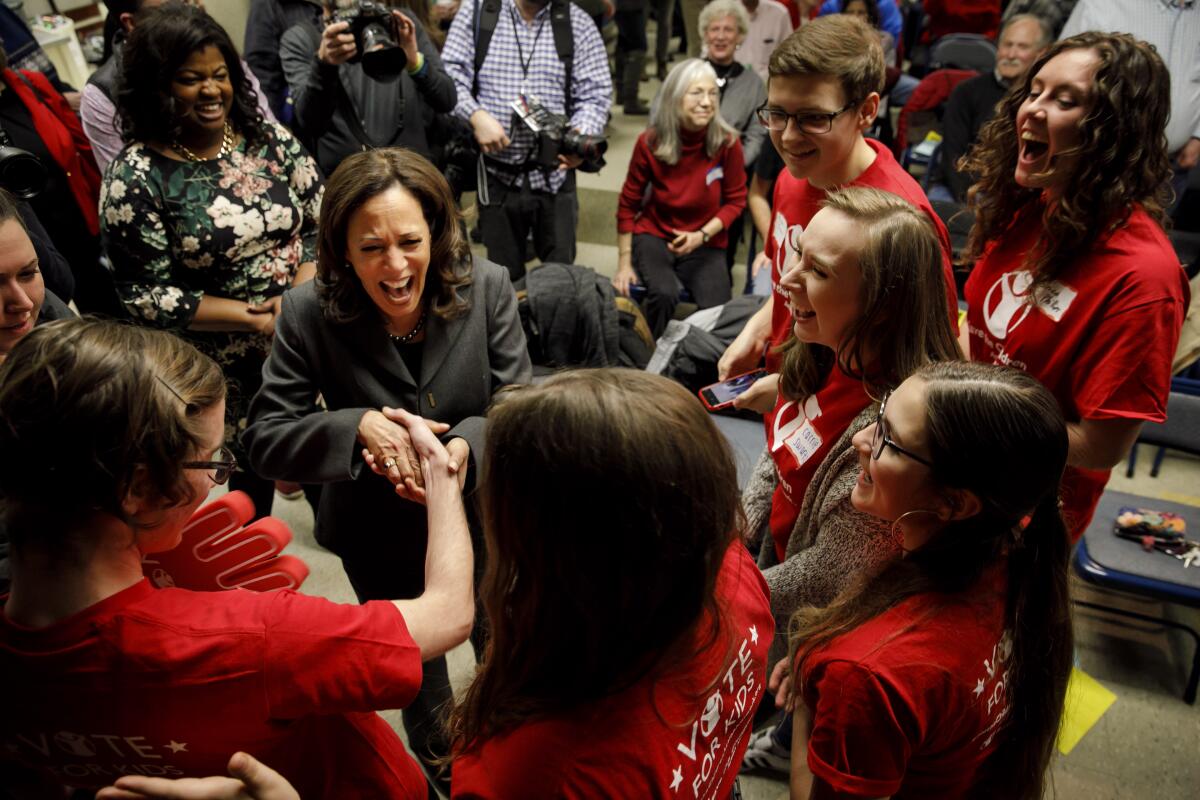
Then-Senator Kamala Harris at an event in Ames, Iowa, in February 2019.
(Marcus Yam/Los Angeles Times)
But she has also been criticized for being overly cautious and unwilling to take a stand on hot-button issues.
“His 2020 campaign didn’t exactly inspire confidence,” said Jim Manley, who spent decades in the Senate as a top executive aide. “The most concerning thing is that when the campaign started to lose steam, it was plagued by infighting and a massive amount of criticism.”
Manley said that while Harris must “play her cards absolutely perfectly” and do a better job of communicating, “she’s strong enough to do that, which is why Trump supporters are getting nervous.”
Born in Oakland in 1964, Harris is the daughter of two immigrant graduate students. Her late mother, Shyamala Gopalan Harris, was an Indian cancer researcher; her father, Donald Harris, was a Jamaican economist.
Harris’s parents divorced when she was 7, and her mother became the primary caretaker and controlling influence for her and her younger sister, Maya.
“There is no title or honor on earth that I will cherish more than to say that I am the daughter of Shyamala Gopalan Harris,” she wrote in her 2019 memoir, “The Truths We Hold: An American Journey.”
After college, she worked as a prosecutor in Alameda County and San Francisco, where she made her first foray into politics when she ran for district attorney and overcame stiff odds to defeat Democratic incumbent Terence Hallinan.
During the campaign, she positioned herself to the right of the progressive DA, as a law and order candidate. With one exception: she made it clear during the campaign that she was against the death penalty.
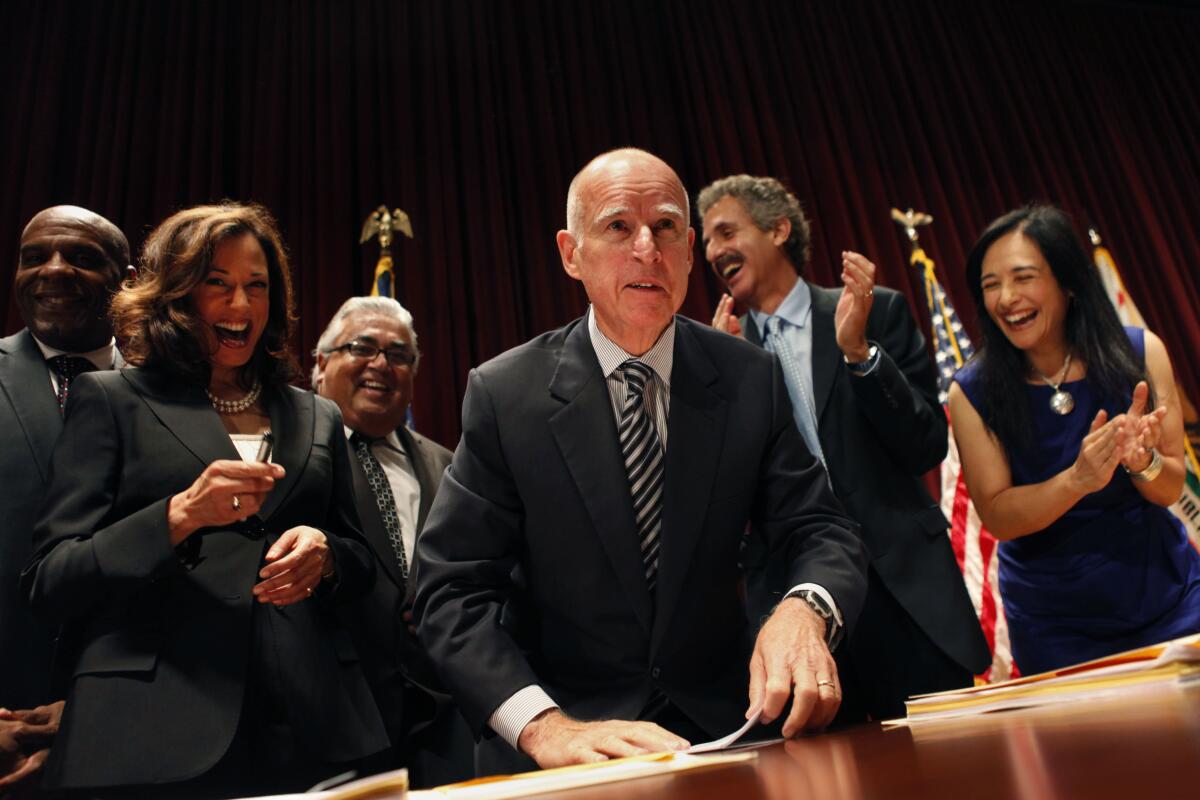
Then-California Attorney General Kamala Harris with Gov. Jerry Brown in 2012.
(Patrick T. Fallon/For The Times)
Four months after Harris was elected, San Francisco police officer Isaac Espinoza was shot and killed by an alleged gang member armed with an AK-47 while patrolling the Bayview neighborhood. Shortly after Espinoza’s death, but before he was buried, Harris said she would not seek the death penalty in the case.
Harris attended the funeral at St. Mary’s Cathedral, as did Sen. Feinstein, then-California Attorney General Bill Lockyer, and hundreds of police officers. As Harris sat in a pew in the front row, Feinstein and Lockyer both demanded that the attacker be sentenced to death.
“She’s taken an incredible amount of criticism,” said Dan Morain, author of the 2021 biography “Kamala’s Way” and a former Times reporter. “I think it’s made her more cautious about taking public positions on very controversial issues.”
Years later, as attorney general, Harris worked in court to uphold California’s death penalty despite her personal opposition, putting her at odds with progressive criminal justice reform advocates and fueling perceptions that she was wavering.
But as attorney general, she also drew national attention for refusing to defend Proposition 8, the California ballot measure that banned same-sex marriage — a political risk that boosted her political profile and helped pave the way for massive cultural change.
In multifaceted California, and as she entered the national Democratic race, Harris’s multiracial background was a political asset that drew comparisons to former President Obama. Harris created her own multiracial, blended nuclear family when she married Doug Emhoff, a white Los Angeles entertainment lawyer, in 2014 and became a stepmother to his two children, Cole and Ella, earning her the nickname Momala.
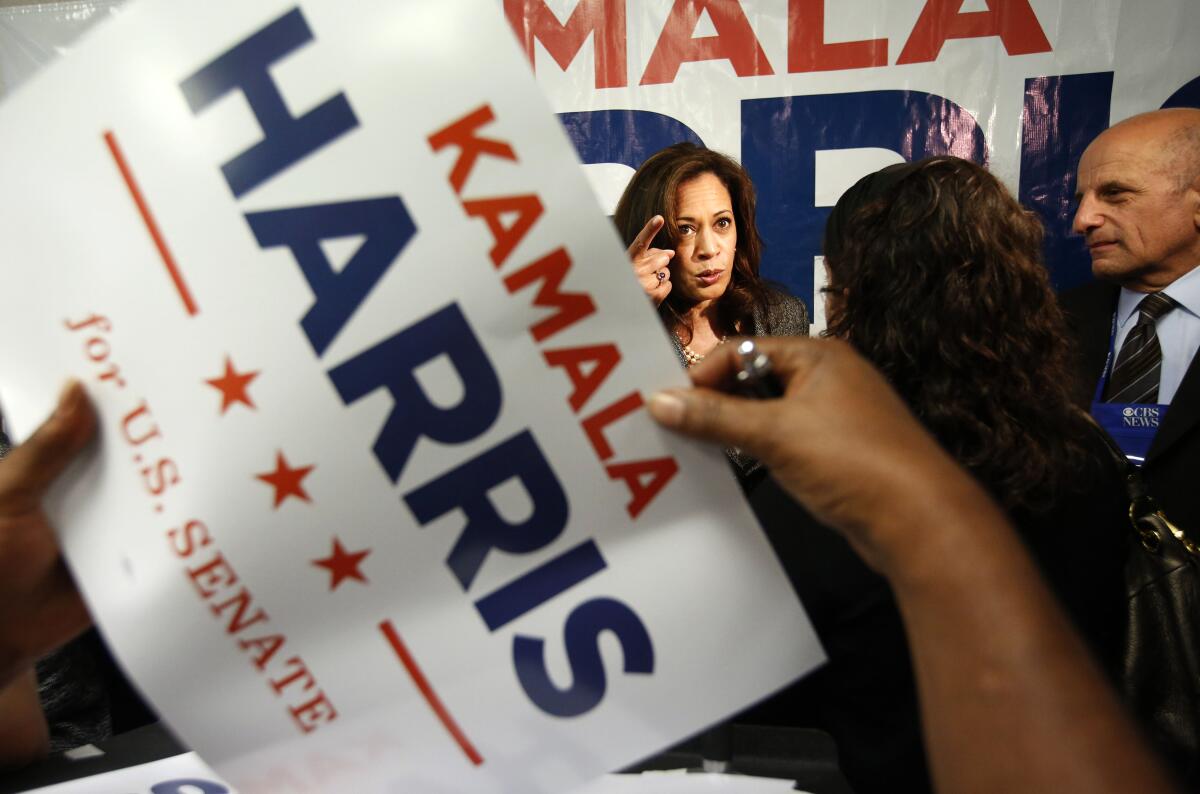
Harris is campaigning for the U.S. Senate in 2016.
(Barbara Davidson/Los Angeles Times)
In November 2016, Harris, endorsed by Obama and Biden, won election to the U.S. Senate, becoming only the second black woman to do so.
But her decisive victory was overshadowed by the election of Trump, whose defeat by Democrat Hillary Clinton stunned members of both parties. In a speech to her supporters on election night, she said: “When we are attacked and our ideals and our core values are attacked, do we retreat or do we fight? I say we fight!”
The Trump era has given her even more visibility. In the Senate, she has flexed her prosecutorial skills in hearings. She questioned conservative Supreme Court nominee Brett M. Kavanaugh so forcefully that video clips of her performance have been circulating on social media as a kind of audition tape for his 2020 presidential campaign.
Her presidential bid quickly fell flat as she failed to distinguish herself in a crowded Democratic field and her campaign was hampered by staff infighting and poorly defined messaging.
Still, she made a strong impression during a Democratic debate, attacking Biden for working with Senate segregationists decades ago to oppose school busing.
“There was a little girl in California who was in the second class to enter public schools. She was bused to school every day,” she said. “And that little girl was me.”

Harris joins President Biden as he greets former President Obama at a White House event in 2022.
(Kent Nishimura/Los Angeles Times)
When Biden and Harris were elected together the following year, Harris, dressed in athletic wear, was filmed calling to congratulate Biden in what became a viral moment where she declared, “We did it, Joe.”
As vice president, Harris was closely watched by the media and fellow Democrats, both because she was a revolutionary figure and because of Biden’s advanced age and much-questioned prospects for a second term.
The attention paid to Ms. Derrickson was not always flattering. Her critics said her early turnover was a sign of weakness in her management style. Her supporters said that as a woman of color, she was subject to a double standard, and faced more scrutiny than her white male predecessors.
“She’s underrated. There’s more than one level to it,” said Morain, the biographer.
Sen. Laphonza Butler (D-Calif.), who has known Harris for 14 years and served as her adviser during her failed 2020 presidential bid, said she has watched the vice president navigate many political minefields.
“She is a woman who literally strives to bring people together,” Butler said. “And even when the criticism is directed at her, she strives to find themes and even concepts in those criticisms, to bring unity and consensus.”
Times staff writer Faith E. Pinho contributed to this report.

